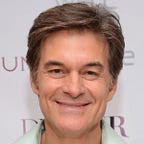How Our In-Studio Production Adapted to Stay On-Air During the Pandemic
By: Mehmet Oz, M.D., Alex Guerrero, M.D., Michael Crupain, M.D.
Much of the media attention on COVID-19 strategies has focused on the politics of statewide decisions by governors. Yet the frontline, private-sector battle to open business during COVID reveals important insights that can benefit all, especially as we reassure employees and customers of workplace safety and build confidence that future waves of this and future viruses can be managed by businesses. “The Dr. Oz Show” remains the world’s №1 health show and shares health information with millions of daytime U.S. network TV viewers as well as those in dozens of other countries, so we have had access to cutting-edge information on COVID-19 through our guests and medical research team.
In March 2020, our staff had similar concerns as the entire country, and we urgently moved our daily show production to the host’s home studio. As we contemplated returning to in-studio production last summer, we worked with our New York City-based CBS studio, spoke with Union representatives, and hired our own on-site medical team to supervise an aggressive screening and testing protocol. We were perhaps the first TV team to return to full in-person production last August, so a review of our experience as we near completion of our taping season is worthwhile. The best practices discovered by businesses like ours should inform public policy and support a more flexible local approach to future health crises.
For the eight months from August to April, we had 56 regular employees that had access to the TV set and 212 individuals who had occasional access, such as freelancers or show guests. To reduce exposure, the majority of guests joined the program via the 800 zoom interviews that we conducted.
We screened people on 167 days, which resulted in almost 4,000 individual screening days. Twenty individuals were kept from the workplace due to minor self-limited symptoms. All tested negative for COVID-19 and were able to return to work. Fifteen individuals had to quarantine due to significant community exposures. Nine individuals had planned loss of workplace access due to travel quarantine.
Testing was performed using almost 2,500 lab-based PCR assays. Three individuals tested positive, although one was later determined to be a false positive due to lab clerical error. This is a recurrent concern that must be addressed with more precise testing and a clear protocol to overcome the error, since the false-positive rate when these tests are used for asymptomatic screening is estimated to be least four-times greater than true-positive rates. Contact tracing of the two true-positive employees revealed no significant workplace contacts. In other words, when someone tested positive, it had no impact on anyone else at the workplace as a result of the proactive approach to social distancing. Furthermore, we had no known COVID transmission at the studio or support areas.
Morale improved continuously as staff and guests became comfortable that our aggressive testing and screening were successfully preventing workplace COVID-19 spread. We embedded a nurse within the studio to facilitate culture change and free employees from the awkwardness of policing each other. We also conducted a provocative thought experiment by asking employees to imagine the number of staff who would need to be quarantined if they personally tested positive for COVID-19. Preemptive reduction of staff in the control room and other opportunities to social distance reduced the risk of a positive test mandating widespread contact tracing. Finally, the medical staff shared all concerns over cases and updated staff on our team’s results just like a physician would address any personal health issues.
We found our local approach to be more nimble and customizable than top-down approaches often mandated at the federal and state levels. We also avoided the politics that thwarted thoughtful implementation of best practices to combat COVID-19. In contrast, as members of the media, we were acutely aware of the intense attention on the politics of decisions made by elected officials. Possibly as a result, our nation managed a nonpartisan virus with an increasingly partisan response. Republicans and Democrats argued over everything from returning to work to dining in restaurants to reopening schools. Our partisan divide was notable even by international standards, as evidenced by a Pew Research Center survey of 14 nations highlighting that no country was as politically divided over its government’s handling of the outbreak.
Gaps even arose over the source and veracity of information. When a fire hose of data is pouring into our minds daily, society often lacks the wisdom to properly interpret the meaning. Having a trusted process with clear goals provides flexibility to adjust a local response without clunky mandates. The private sector knows success depends on delighting our customers. When fighting a pandemic, this translates to over-delivering safety and proving efficacy so we can control our destiny. We need to gift each other the discipline of hope.
